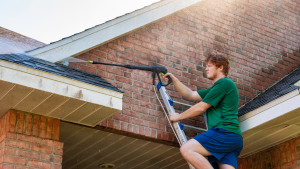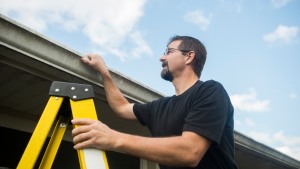Although stucco siding is commonly used in warm climates, it will eventually need to be repaired and coated like any other type of exterior siding.
Due to the widespread belief that it is highly durable, many people choose to stucco their homes’ exteriors.
Stucco can indeed last for decades; it’s not unusual for the stucco to last for 100 years or more; however, it will still require maintenance. Here are some instances in which stucco siding repair is warranted and the benefits of an elastomeric coating.
Knowing when stucco repairs are necessary is the first step. When it’s in good shape, your house can withstand any crisis. However, when holes or cracks appear in it, it can allow unwanted outsiders to enter your home.
In time, it can become a portal for water, insects, and other pests to enter your home. You need to head these issues off at the pass.
The stucco on your house should be inspected regularly. Observe the stucco as you make your way around the building.
- Are the majority of the problems solved?
- Is the paint holding up okay, or are there problems?
Like any other material, the stucco degrades and looks old and worn with time. You must inspect the stucco for damage, such as cracks, gaps, or blisters. It’s broken and needs fixing if you see that message.
Reasons For Stucco Damage
Before beginning any repairs, you must first determine what caused the damage to the stucco siding. In doing so, you can ensure that you won’t have to deal with the same issue again in a few months when you’ve given it the attention it deserves.
The stucco on your home could be damaged due to the following:
Incorrectly applied:
Numerous coats of stucco are typically used. You’ll notice that the stucco is more likely to crack and break if one of the layers isn’t applied correctly.
Water damage:
Stucco is vulnerable to cracking and collapse if water penetrates it. Verify the application was made correctly, as doing so in wet weather renders the product ineffective.
Before repairing stucco siding, you should ensure no water is getting in. This could be due to a leaking downspout or an unweatherproofed window or door.
How to Fix Your Stucco
Since you now know what went wrong with your stucco, you can fix it and make it look new. Fortunately, it’s not hard to repair, and the work you put into patching it up will last for years
.
- Chip Away Damage
The broken stucco must be chipped away first. With the hole provided by the crack or blister, that should be pretty easy. For less wall dust, you can dampen the area first.
- Apply Tar Paper
After that, re-tar the exposed wall area. Ensure that there is an overlap between the new and old paper when applying this paper. This will prevent leaks in the wall from worsening inside the house.
- Add Metal Lath
Fixing the new metal lath to the wall requires a patch. This is the surface that your new stucco will adhere to.
- Patch With New Stucco
At this point, you can apply new stucco to the wall. A patch kit, which can be purchased from most hardware stores, eliminates the need to measure precise amounts of cement for a successful repair.
To the provided instructions, apply it to the damaged area. Allow the patch to fully cure before painting to fit in with the crowd in the house.
Using Elastomeric Coatings On Your Stucco
After fixing any damage to the stucco, a new coat of paint will make the house look new. It’s ideal to do the painting now because you’ve established that the stucco is in good shape and will accept a fresh coat of paint without issue.
Stucco typically must be repainted every 5-10 years if no repairs have been made and the project is planned. If you’re doing some painting, use the highest quality paint you can find. Better quality paint will last longer when exposed to the elements.
If you use higher-quality paint, you will notice a difference. Not only will the overall appearance of your home be enhanced, but the stucco’s longevity will also be enhanced.
Benefits of Coatings
Elastomeric paint has become one of the most common finishes for stucco. Just like the name suggests, this paint can be stretched. It can swell or shrink depending on the temperature outside.
This means you can get more years out of a paint job without worrying about cracking in cold or hot temperatures. Elastomeric paint is one of the best paints to use on the sidings of your home because it was explicitly developed for stucco.
Coating Application
Please make sure there are no paint voids while applying it. Although elastomeric paint is watertight, it is only completely waterproof if no cracks or crevices exist. Increasing numbers of homeowners are selecting this paint for their sidings, and it’s simple to understand why. There will be significantly less wear and tear on your stucco over time if it is waterproof and elastic.
Since water is kept out, sidings are less prone to rot. This is terrific news for you since it means less cracking as it extends.
If you need your stucco painted, it’s usually best to hire a professional painting crew to do the job. They’ll be able to paint it without leaving any gaps or sloppy edges, making it watertight.
Conclusion
It would help if you now understood why repairing stucco siding is important. It should be patched up and coated with elastomeric paint to prevent further wear and tear.




